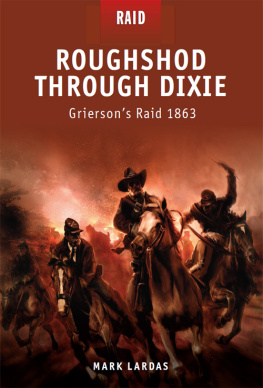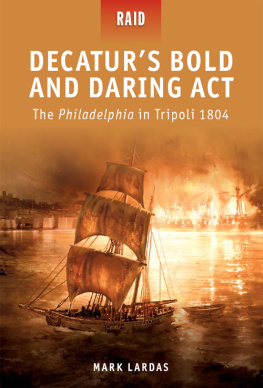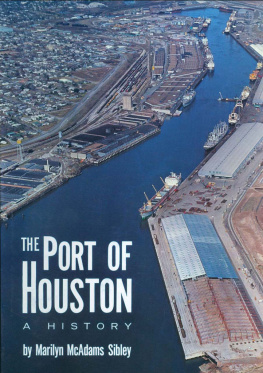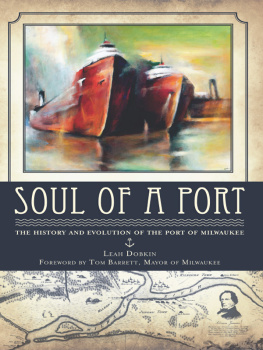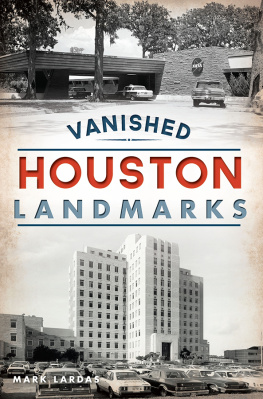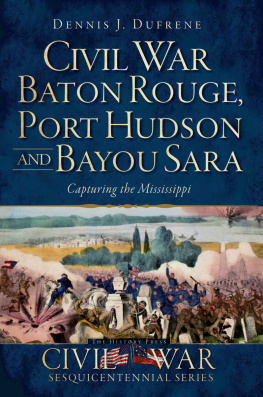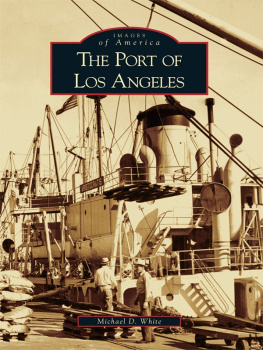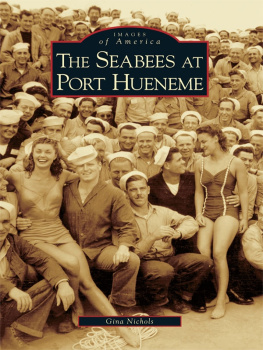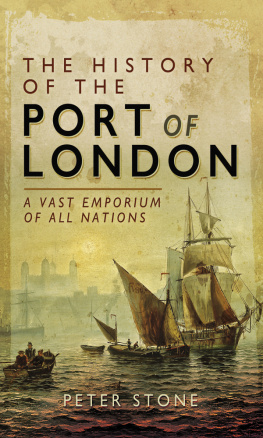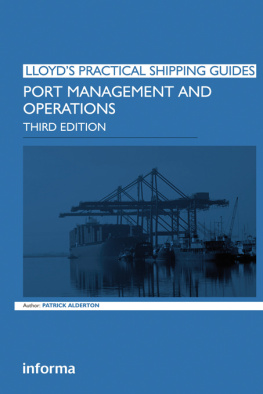ACKNOWLEDGMENTS
No book is the product of a single author. Many folks helped me as I wrote and assembled this volume, and I would especially like to note those mentioned here.
The Houston Maritime Museum provided tremendous support for this project. Special thanks have to go to former director John Kendall and current director Diane Lipton, as well as to Mary Barnes and Heather Schiappa. Thanks also go to Burt Reckles, a docent at the Houston Maritime Museum as well as a friend and fellow ship modeler.
The Port of Houston Authority also provided invaluable support, especially Leslie Herbst, Phil Hensel, and Deya Martinez. Without them, I would not have found many of the most striking images in this book.
My deep gratitude goes to Michele Reilly, head of digital services at the University of Houston. She went above and beyond the call of duty to help me acquire images from the universitys digital archives. It is worth a visit at http://digital.lib.uh.edu/.
Special thanks go to Robert Thompson of the Houston Pilots Association. He made an effort to allow me to accompany him as he piloted a ship through the Houston Ship Channel, but circumstances made it impossible to take up his offer.
I would also like to thank Laura Bruns, my acquisitions editor at Arcadia Publishing, for her assistance.
Finally, thanks go to my wife, Janet, for her support during this project.
The following abbreviations indicate the sources of the images used in this volume:
ACauthors collection
HMM Houston Maritime Museum
LOCLibrary of Congress
NARANational Archives
NASANational Aerospace and Space Administration
POHAPort of Houston Authority
UHDLUniversity of Houston Digital Archive Library
USACOEUS Army Corps of Engineers
DISCOVER THOUSANDS OF LOCAL HISTORY BOOKS
FEATURING MILLIONS OF VINTAGE IMAGES
Arcadia Publishing, the leading local history publisher in the United States, is committed to making history accessible and meaningful through publishing books that celebrate and preserve the heritage of Americas people and places.
Find more books like this at
www.arcadiapublishing.com

Search for your hometown history, your old stomping grounds, and even your favorite sports team.
BIBLIOGRAPHY
Alperin, Lynn M. Custodians of the Coast: History of the United States Army Engineers at Galveston. Galveston, TX: Galveston District, US Army Corps of Engineers, 1977.
Hall, Andrew W. The Galveston-Houston Packet: Steamboats on Buffalo Bayou. Charleston, SC: History Press, 2012.
Sibley, Marilyn McAdams. The Port of Houston: A History. Austin: University of Texas Press, 1968.
Trimble, Frances G. The Houston Pilots: Silent Servants of Progress. Houston: Houston Pilots, 2004.
Vela, Lee and Maxine Edwards. Reaching for the Sea: The Story of the Port of Houston on Its 75th Anniversary. Houston: Port of Houston Authority, 1989.
www.portarchive.com.
One
A VISIT TO THE PORT
Take a visit to the Port of Houston. Many visitors seeking to see the port stop off at Allens Landing first. The Allen brothers were said to have founded Houston there, taking a steamboat up Buffalo Bayou as far as it would go. Today, Allens Landing is a park in Houstons downtown. It does not match expectations of what a seaport should look like. Today, it cannot be seen as a place that river steamboats could have reached, much less oceangoing ships. The bayou there seems too narrow for a bargeor maybe even a canoe.
Many are curious about the Port of Houston, which is a major part of the citys identity. Ask anyone to tell two things about Houston. Most will say that it is Americas space city and a seaport, or that it is the oil capital of the United States and a seaport.
Visitors can tour the port aboard the Sam Houston, for those curiosity move beyond Allens Landing. The tours are free, take 90 minutes, and depart every day but Monday. It is another opportunity to learn a little about the port.
Visitors must show picture identification to enter the port when they arrive at the gate. Since 9/11, the Department of Homeland Security requires this. They are directed to a parking lot next to a pavilion marking the Sam Houstons dock. Sam Houston is all white and 95 feet long, with a two-level deckhouse set jauntily amidships. It reminds many of a plastic toy boat owned in childhood. Perhaps that is not so strange. Sam Houston is older than many realize, launched in 1957. A toy maker might easily have modeled a childhood toy on a ship like Sam Houston.
When visitors explore the ship, they will discover plenty of space for the people taking most tours. A full house will run 80 to 100 people, something that usually happens on weekends. The boat has an air-conditioned lounge, which is really nice on a summer day. Really fortunate visitors take the trip on a warm winters day, when it is comfortable standing on deck, outside the lounge, so the port can easily been viewed
In the lounge, a big mural showing a stylized view of the Port of Houston was placed. Burly men with forklifts move pallets of cargo. Brawny longshoremen load sacks, bales, and forty-gallon drums onto other pallets to be lifted into the holds of ships. The ships have graceful clipper bows, a deckhouse and smokestack amidships, and booms and masts in front of and behind the central island. This was what the port looked like back when the Sam Houston was launched, in the middle of the 20th century.
The big diesel engines of the Sam Houston come to life. Visitors feel the vibration on the deck through their shoes. The ship moves away from the dock. Until then, visitors are confined to the lounge.
Those exiting the lounge then to look at the harbor first notice three large ships, painted medium gray. Other ships are colorfulin reds, oranges, black, and white. These three are drab. Even their names are painted in a dull black: Cape Taylor on one, Cape Texas on a second, and Cape Trinity on the third. Most of the other ships seen are hives of activity. These three are quiet, seemingly forgotten. They look like naval ships, despite the Port of Houston being a commercial port. They are Ready Reserve Force fleet ships that support the United States military. These roll-on/roll-off ships are used to move army vehicles, if tanks and other military vehicles at Fort Hood, Texas, need to be moved to some trouble spot. These ships look different than the ones in the mural. In fact, most ships look different. The deckhouses and smokestacks are at the back. The booms and masts are missing. The hulls seem blunter. Many ships are piled up with shipping containers, often piled six high above the deck. Visitors can only guess how many more are hidden within the hull.
Now, the Sam Houston has turned 180 degrees and is cruising downstream, heading towards Galveston Bay. Literature on board calls this area the Turning Basin. It is a notch in Buffalo Bayou. Its purpose is to give ships a place to turn, so they can point their bows back downstream. It would be hard to have to back a ship the length of the bayou, until it reached Galveston Bay. Thoughtful visitors often wonder if a ship could turn in Galveston Bay. Isnt it too shallow for deep-draft ships?
Now, Sam Houston is moving downstream. The term bayou brings the image of narrow, winding waterways choked with trees growing in shallow, muddy water and fallen timber. While the water is muddy, Buffalo Bayou looks like a river. It is not all that wide right here, maybe 500 feet, but at this spot it seems fairly straight, with gentle curves. What is striking is how crowded it seemsnot the center channel, in which the
Next page


